
MAY CONTAIN NUTS

Search Shorpy
SHORPY ART

Framed or unframed, desk size to sofa size, printed by us in Arizona and Alabama since 2007. Explore now.
Join and Share
Ad-Free Shorpy
Shorpy is funded by you. Patreon contributors get an ad-free experience.
Learn more.

Recent comments
- I wondered the same thing.
- The location in 2009
- Pill Pusher
- Roll your own
- Rugged and real!
- Civil War history
- Early EV?
- A Charles Purcell - Mama Cass Connection
- Uncle SAAM
- Obfuscation
- One Chocolate Soldier rode away
- Victor Marquis de la Roche
- The Little House Across Way ...
- Vanderbilt Gates
- Vanderbilt Mansion
- You can still see that gate
- Withering heights for me
- So Jim,
- Top Heavy
- Re: Can't Place It.
- Bus ID
- Since you mention it
- The White Pages ?
- Moonlight Tower
- 1907?
- Fire(men) and Water
- Can't Place It
- Can anyone
- Wings
- Where's Claudette and Clark?
Member Photos
The Shorpy
Printporium
Printporium
Search Shorpy
Search results -- 30 results per page
- California Building: 1942
- May 1942. "Denver, Colorado." Whose California Building poses that incendiary interrogative, ... quote says "In 1923 Clara and Russell Stover of Denver, Colorado, made their first candy for sale in the kitchen of their bungalow ... Posted by Dave - 02/19/2022 - 12:01pm -
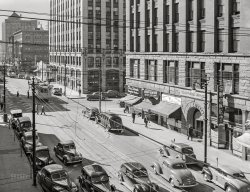
- Bird Herder: 1939
- October 1939. Chaffee County, Colorado. "Paul Arnold, son of FSA client. Herding turkeys." Gobbler and ... Posted by Dave - 11/23/2022 - 10:56pm -
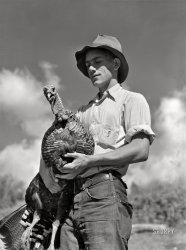
- Texaco: 1925
- ... a four story office building at the corner of Missouri and Colorado ("Brightwood Bistro" on the first-floor awning).
It might be ... Posted by Dave - 09/13/2011 - 9:38pm -
![Texaco: 1925 1925. Washington, D.C. "Texas Company, Georgia Avenue and Military Road." Gas now 20 cents a gallon for regular, 23 for Texalene Benzol Blend. As we can see, this was during the Great Splotch Epidemic of 1925. View full size.
Google views etcWhile I appreciate that some people live in the pictured areas and have inserted Google maps and enlargable color views, I only find them annoying. Frequently when I try to view a picture "Full Size", I have to scan through a bunch of modern views that do not interest me at all since I do not live in the area. Hate to sound like a curmudgeon, but it is very annoying to have this happen as it slows things down while the maps and pictures load.It seems to have become a rampant disease to put these modern photos in with our old pictures. I go to Shorpy to see how things used to be, especially the vehicles and signage.
Gas Wars!Inflation must not have been an issue back then. I can remember paying that same 23 cents in 1968.
The PitsGreat little grease pit (as we called 'em when I was a lad) and station. It looks like the grease monkey had to slip under the car or perhaps only pull it partway over the pit to grease it. "Gasoline alley" (at Indy) must've had these during its early years, hence the term "the pits."
Third time's the charmTimeandagainphoto was close, and Mr DCMemories was off by a couple of blocks. Here's the view today (note the identical building on the right).
[Timeandagain wasn't off at all -- he was pointing out the rowhouses in back. - Dave]
View Larger Map
Gasoline Goes Big TimeCompared to the pitiable "Gas Shack," the Texaco chain obviously attended business school and learned all about brand development and image. Consistent use of logos, repeated everywhere, and a snappy little iconic building, presumably out of the corporate stylebook, promoting respectability through "better architecture," and even though standardized, still made of solid materials.
Service pit.To the left of the station is a service pit for changing oil and greasing bearings. No need to crawl under the car, just walk down a few stairs and look up.
Open pit reduxA neighbour in the town where I grew up had a oil-change pit in his backyard garage!
It wasn't a particularly old house; 1950s vintage I suppose.
It was covered with planks much of the time, but I recall seeing "Butch" down there with a hanging lamp a few times. I never knew how he got down there; most likely a ladder since there wasn't room for a set of stairs.
Michelin man running.I thought he'd lost a little weight recently!
Georgia Avenue and Rock Creek Ford Road NWThis view is looking northwest to the corner of Georgia Avenue and Rock Creek Ford Road, NW. The rowhouses in the background are still standing which front on Rock Creek Ford Road at the corner of Piney Branch Road.
View Larger Map
And let the yuppies find homesBrand new housing complex, "6 rooms, $8450."
Appear to be pretty nice housing, definitely lots of porch area.
Historical markerIn the Google Street Views, there is a historical marker on the island between Missouri Avenue and Rock Creek Ford Road. When you zoom in on it, one side of the marker says (I believe) "Battleground to Community" and has indistinct old photos (perfect for Shorpy?). From another angle, the back of same marker seems to show a historic photo of the building across the street from it, a four story office building at the corner of Missouri and Colorado ("Brightwood Bistro" on the first-floor awning).
It might be interesting to see if the old photos from that marker could be found and presented on Shorpy, with an explanation of their historic significance.
View Larger Map
Georgia and Military, now MissouriThis eastern continuation of Military Road is now part of Missouri Avenue. There has been a service station on this intersection all of those years.
View Larger Map
Michelin tiresI live near Clermont-Ferrand, France, the historical birthplace of the Michelin Company, so this Michelin tires ad in 1925 in the USA is a pretty interesting sight. Thanks Shorpy.com !
Open PitI used to work in a garage that had an indoor grease pit, where there were numerous instances of human error resulting in injury. Whoops, plop!
I can't imagine one uncovered and outdoors. Talk about an accident waiting to happen!
Brightwood Heritage TrailThat marker is from the Brightwood Heritage Trail. Cultural Tourism DC has lots of those neighborhood trails all over Washington.
BucolicAs a resident of DC, I can't get over how positively rural this view is. Incredible how far a city can come.
Cheaper, but not so cheapFor anyone interested, using a standard web-based inflation adjustor, 20-cent gasoline in 1926 is equivalent to gas at $2.40 a gallon today; the 23-cent stuff would cost $2.76.
Assuming improvements in octane rating and engine efficiency since the 1920s, the real cost in miles per dollar probably isn't much different, and today's gas may actually take you farther per (inflation-adjusted) dollar.
Re: Google views etcIn response to Jesse Livingston's comment, I enjoy seeing the modern photos posted by readers. It's interesting to compare new with old, and it sometimes helps by putting the old photo in context.
Amazing To See What Used to Be The house I grew up in is northwest of and about a 20 minute walk from this spot. My grade school (until 3rd grade) was Brightwood Elementary, 5 mintues west on Military Road.
I may have seen this place as a gas station when I was little but I do remember it as a convenience store and I think maybe a place that sold alcohol. In any case, my parents never went there, so I never did, either.
(The Gallery, D.C., Gas Stations, Natl Photo)](https://www.shorpy.com/files/images/27313u.thumbnail.jpg)
- Throwing Horses: 1900
- ... that took place during the Plains Indian wars in northeast Colorado in 1868.
Canine Great dog.
N. Y. Giants Revisited ... Posted by Dave - 08/02/2012 - 9:52pm -
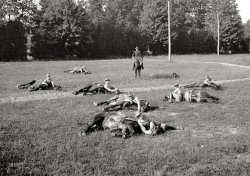
- Logan's Heroes: 1942
- May 1942. Kremmling, Colorado. "Soldiers from Fort Logan hitchhiking along U.S. Highway 40." Acetate ... Training Command, which had a branch at Lowry Field, Colorado. As opposed to flight instruction, the Technical Training Command ... Posted by Dave - 02/18/2022 - 2:15pm -
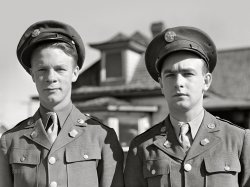
- Little Rock: 1910
- ... to make public announcements.
Also, whey does Colorado have a Boulder, and Arkansas only has a Little Rock? Is it because ... Posted by Dave - 08/14/2012 - 7:02pm -
![Little Rock: 1910 Little Rock, Arkansas, circa 1910. "Main Street north from Sixth." 8x10 inch dry plate glass negative, Detroit Publishing Company. View full size.
KressWe see the five and dime store, Kress. Kress, a national chain in its day, is not to be confused with SS Kresge, that company survived to found Kmart and eventually control Sears as well. The company is now called Sears Holding.
Blocks and Blocks of Wonderful BuildingsIf you follow the buildings on down the street, you can see what a pretty downtown Little Rock had.
It has a few businesses that were also in Dallas in that time. The ones I can spot are Kress Variety Store, Droughon's Business School and Metropolitan Life Insurance.
Note the sign that designates the corner. In those days they often met each other on the corner of two main streets. In our Dallas history I have found that prominent corners were often used by speakers to make public announcements.
Also, whey does Colorado have a Boulder, and Arkansas only has a Little Rock? Is it because rocks that roll down the Rockies are bigger than rocks that roll down the Ozarks?
Now and ThenWhat consistently strikes me about the "now vs. then" picture comparisons is that the present day views are devoid of pedestrians and therefore feel without character - lifeless, even (another example here). I'd much rather visit the "then" places than the "now." Maybe I'd see Minnesota Fats sauntering out of one of those pool halls with a pocket full of sucker bucks.
Waiting Outside the Pool HallThe woman in front of the pool hall with her hand on her hip could be aggravated because her husband is loitering in the pool hall. But, again, she could be positioned in a great place to attract some customers. You never know. Men were men and women were women back in those days too.
Dark armsAbout those crossarms on the power poles: they're all black, or heavily coated in creosote.
[Those are telephone lines on what look to be metal crossarms. - Dave]
Pool HallI bet the woman standing on the corner in the hat and full length frock THOROUGHLY disapproves of the Pool Hall!
In fact she's probably telling those guys next to her exactly where they'll be going if they go in there.
Some of it remains, but not muchThe large white building to the left (The Boyle Building) still stands, while (unfortunatly) the domed Masonic Temple to the right burned in 1919.
View Larger Map
More pics and stories from the site of this photo
Ya got trouble!Friends, lemme tell you what I mean.
Ya got one, two, three, four, five, six pockets in a table.
Pockets that mark the diff'rence
Between a gentlemen and a bum,
With a capital "B,"
And that rhymes with "P" and that stands for pool!
Gotta love Professor Harold Hill!
[He's especially loved today. - Dave]
Little Rock's first skycraperThe white building on the left is the 12 story Boyle Building. It was built in 1909. I believe the pic was taken closer to an area midway between 7th and 8th street. The building with the dome on the right is no longer there and I don't remember it from the 40's or 50's.
LocalThis is the same view I see from the front door of our office, the AR DHS building. I don't recognize a lick of this.
Don' step in the ...I'm glad to live in a time and place where horse droppings in the middle of the street would be considered an oddity.
Smoking and Playing PoolImagine a place to play pool and smoke too. My how times have changed.
Bracy HardwareThanks for this photo! On the right side of the street is the E.D. Bracy Hardware Store. It was named for Eugene Daniel Bracy (b. Dec. 7, 1876).
His brother, William Frederick Bracy (b. May 17, 1870; d. Nov. 13, 1934), also worked at this store and was married to my great-aunt Frankie Newton (b. Sept. 11, 1877; d. June 9, 1944).
I've only seen, prior to this photo, only fuzzy postcard views of the street and buildings, so this is quite the treat!
Three legged horseIn the lower right just next to Hollenburg Music is a wagon or cart being drawn by a horse with three legs. And The cart has no wheels, just these strange bow-shaped objects beneath it. Now I KNOW that movement blurs things in long exposures, but would it distort the straight spokes of a wagon wheel and remove a horses leg? (That wagon must have been moving at quite a clip!)
[The fourth, invisible, leg is the one that didn't stop moving during the exposure. The curved-spokes artifact is seen in many of these images, including the one below. The spokes are revolving around an axis that's moving linearly. You can approximate the effect by loosely holding a pencil at its center and waving it up and down so it looks "rubbery." - Dave]
+105Below is the same view from July of 2015.
(The Gallery, DPC, Little Rock, Streetcars)](https://www.shorpy.com/files/images/4a19785a.thumbnail.jpg)
- Branding: 1939
- ... We used to drive through, or near, Dumas on our way to Colorado from East Texas - usually inspiring a rousing rendition late at night. ... Posted by Dave - 06/15/2008 - 10:18pm -
![Branding: 1939 September 1939. "Hamburger stand with old cattle brands. Dumas, Texas." 35mm negative by Russell Lee for the Farm Security Administration. View full size.
Swastika BrandI'll bet that swastika brand over the door disappeared fairly soon after this photograph was taken.
Cola SignsI count five Coca-Cola signs vs. three Royal Crown signs. Coke wins, at least for these two sides of the building. Do you think one of the other sides has a Golden Arches brand?
Give me a signThe bent cross/sun/good luck symbol (swastika) was used by Arizona on highway route markers well past World War 2. Check out the 1948 shield.
Before National Socialists hijacked this symbol, it was used by many cultures and societies, including Native Americans.
Drive-throughThat's the earliest drive-through I've ever seen. In-and-Out Burger says they built the first drive-through restaurant in 1948.
Isn't there a sixth Coca-Cola ad on the strut/handle across the screen door?
SwastikaThe swastika was a good luck sign in both Indo-Asian and North Amnerican Indian cultures long before the Nazis perverted it. In those cultures, it was usually rendered reversed from the Nazi presentation. It is still considered a "good luck charm' by some Asians which startles Westerners who encounter it.
Them's Good BurgersI'm getting hungry just thinking about how good those burgers must've been. It being Texas, it's a safe bet to say the beef was fresh.
RC ColaIn Dumas, Texas...TRUST ME...RC Cola sells better. As someone once told me in NYC---"RC Cola? That's what hillbillies drink!". I took offense at that as I dumped a nickel pack of Planter's Peanuts into my RC.
BrandsIt's amazing how many ancient cultures used the swastika. Since this was taken in Texas, I'm guessing it was associated with either the Navajo or Hopi indians of that area.
SodaAn excerpt from Texas writer Larry McMurtry's "Walter Benjamin in the Dairy Queen":
In the summer of 1980, in the Archer City Dairy Queen, while nursing a lime Dr Pepper (a delicacy strictly local, unheard of even in the next Dairy Queen down the road Olneys, eighteen miles south but easily obtainable by anyone willing to buy a lime and a Dr Pepper), I opened a book called Illuminations and read Walter Benjamin's essay The Storytellers, nominally a study of or reflection on the stories of Nikolai Leskov, but really (I came to feel, after several rereadings) an examination, and a profound one, of the growing obsolescence of what might be called practical memory and the consequent diminution of the power of oral narrative in our twentieth century lives.
How beautifully phrased, especially the bit about the lime Dr Pepper, and the passage introduces a discussion of the issues that make Shorpy images so powerful.
Drive-ToThat doesn't look like a drive-in or drive-through. That car is parked next to it - probably the owner's. If it was a drive-through lane, there'd be tire tracks worn through the weeds. The little window in front with the small shelf is for walk-ups. Or at least that's how every Dairy Queen and walk-up food place I've ever been to works.
"Ding Dong Daddy......From Dumas" was a song my father (who was not from Dumas) used to hum and sing when he was driving. We used to drive through, or near, Dumas on our way to Colorado from East Texas - usually inspiring a rousing rendition late at night.
RE: Texas cola wars...Dublin, Texas is the only place you can still get original recipe Dr Pepper (a Texas drink) made with cane sugar instead of corn syrup. Good stuff. 10, 2, and 4. Uurrp.
Goober Pea
BrandsThere are some clever brands up there. The 'Bar' BQ and the 7UP brands caught my eye. Once upon a time I wanted a $ sign brand to put on my cattle. My old boss grew up in the Texas Panhandle in the 30s and 40s. He said as a kid you always bought RC Cola because you got two more ounces for the same money as Coke.
Indian ThunderbirdThat brand that looks like a swastika is a Native American symbol representing the thunderbird.
The 45th Division of the US Army in Oklahoma had that design on its shoulder patch. When WW II started, they changed the design to look like a stylized bird because they did not want it to be confused with Hitler's swastika.
Dumas, TexasI was born and raised in Dumas and I can't for the life of me identify the location of this building. I wished I could so that I could walk around it and relive these simpler times. I am guessing that it was on Main street. There wasn't much here back then and the center of town consisted of the courthouse and some businesses and a few hotels.
[Below: More from Dumas. - Dave]
Spirit of '76I was a high school freshman in 1976, and I wrote the date on every school paper with a single-stroke "76" like the one to the left of the swastika. I hadn't thought of that in thirty years...until I just looked at this photo.
Great stuffI broke a fan belt in Dumas in 1974. I stumbled into a local service station and got it fixed quickly and was on my way.
Everyone was really friendly and they didn't try to rip me off. I have that great memory of Dumas.
Mystery solvedI am from Dumas and I was curious as to the location of this hamburger stand. I asked the old timers and got no results for a couple of years of inquiries. Finally, I showed the picture to a friend of mine whose father has always lived here. He went to the rest home where his father, Jim Ed, lived and showed it to him. Old Jim Ed remembered the place, couldn't remember who owned it but his younger brother used to work there. It was located at 9th and south Main on the west side of the street. The building pictured is still there but the structure is the back portion of an operating restaurant called "Nana's". It has been quite the mystery.
(The Gallery, Eateries & Bars, Russell Lee)](https://www.shorpy.com/files/images/8a27184u_0.thumbnail.jpg)
- Pike's Peaker: 1900
- Colorado circa 1900. "A Pike's Peak prospector." 8x10 inch dry plate glass ... Posted by Dave - 08/05/2012 - 3:12pm -
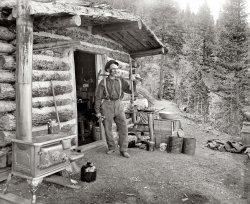
- Skillet Cornbread: 1935
- ... and always cut in pie shaped wedges. Whereas I grew up in Colorado and California where homemade was the norm, my husband grew up here in ... Posted by Dave - 11/29/2015 - 12:37pm -
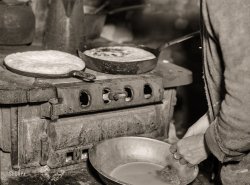
- Million Dollar Highway: 1940
- ... Highway is cut through massive rocks in Ouray County, Colorado." U.S. 550 between Silverton and Ouray. Now a paved modern highway, ...
We lived in Pagosa Springs at the time, and I am a Colorado native, so mountain roads were nothing new to me. But this one was ... Posted by Dave - 04/23/2008 - 9:39am -
![Million Dollar Highway: 1940 October 1940. "Million Dollar Highway is cut through massive rocks in Ouray County, Colorado." U.S. 550 between Silverton and Ouray. Now a paved modern highway, this is a spectacular mountain route that I've driven many times over the years. View full size. 35mm Kodachrome transparency by Russell Lee.
Ouray ActivitiesThe creek you see at the bottom of the photo flows into Ouray and is diverted through perforated pipes set along the canyon rim in the winter. The sheets of ice formed by the water trickling over the rocks create a perfect ice climbing venue, with competitions every January and February. The creek flows into the Uncompaghre River (Native American name meaning "no cell service"). The hot springs in town are a great way to take the chill off your bones after a day on the ice.
[My favorite summer activity: Jeeping the Alpine Loop and exploring the ghost towns along the way. Especially Animas Forks. The Western Hotel in Ouray is a good place to stay. Or the Beaumont if you want fancy. - Dave]
Red Mountain Pass If I am not mistaken this section of road climbs over Red Mountain Pass.
A few years back I rode my bicycle over this pass, with 750 other riders,on the way to Durango. While it is now a "modern paved highway" it still has no guardrails as they would be an impairment to clearing the many feet of snow they get each year. The drop off right next to the edge of the road(first on the right side then the left) made some want to hug the center line, but the car traffic was not conducive to this.
The night before we left for the ride a shop owner in Ouray gave bikers this advice. "For the first 12 miles lean left. For the next 12 miles lean right."
Bus ride anyone?This is truly one of the greatest last frontier drives ever. We used to drive up from New Mexico to play basketball with Ouray and Silverton. This road made bus trips very interesting. Great photo.
HistoryThe Million Dollar Highway got its start in the 1880s as a 12-mile toll road between Ironton and Ouray, a remarkable feat considering it was before the age of the internal combustion engine and done by men with picks and shovels, working in snow and very low temperatures. Drive thru in the winter to appreciate. I've jeeped this area extensively... see pics at
www.fotki.com/tbill and
www.fotki.com/tbilmelms
550I remember riding over this highway during WW2 when I was a very small child. It wasn't paved yet and was just barely passable for two vehicles going in opposite directions. The driver always had to honk when approaching a blind curve, and the car on the outside had to move over and stop for the inside vehicle. I was terrified and spent much of the trip huddled down in the back seat with my eyes closed.
We lived in Pagosa Springs at the time, and I am a Colorado native, so mountain roads were nothing new to me. But this one was the worst. I was between 3 and 4 at the time.
Eek!I have driven this during the summer and even then I wanted to hug the centerline. I can't imagine driving this during the winter.
Golden RuleWhen I was a kid in the 40's, we were taught that the name for the Million Dollar Highway comes from the value of the ore-bearing fill that was used to construct it. As kids, we would gather mill tailings from the road sides in the mountains and take them home to extract gold by crushing and panning. We would alway get a few flakes of gold. I'm sure that there are few or none of these piles of tailings left because the price of gold now makes it profitable to use the very low grade ore.
(The Gallery, On the Road, Russell Lee)](https://www.shorpy.com/files/images/1a34174u.thumbnail.jpg)
- Here Come the Girls: 1953
- ... of Bali is a 1932 documentary directed and filmed by Colorado native Deane H. Dickason. The only reason an old social anthropology ... Posted by Dave - 01/13/2014 - 2:41pm -
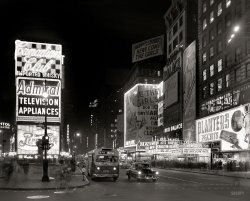
- Married Life: 1904
- ... song, but wouldn't it be nice if this was where they built Colorado Boulevard?
Oh, the memories I wss married to an ass for many ... Posted by Dave - 07/26/2012 - 4:57pm -
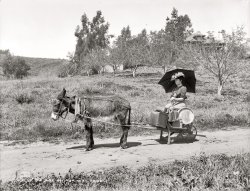
- Looking Down: 1905
- ... on the poles. I worked in a coal mine for a while in Colorado, which was on a steep slope and had a similar inclined track, but ... Posted by Dave - 07/29/2012 - 1:32pm -
![Looking Down: 1905 Dutchess County, New York, circa 1905. "Mount Beacon Incline Railway, looking down, Fishkill-on-the-Hudson." 8x10 inch glass negative. View full size.
Max Elev.Immediately brought to mind "High Tor" by Maxwell Anderson.
Signal wiresI noted the left pair of wires suspended under the brackets on the poles. I worked in a coal mine for a while in Colorado, which was on a steep slope and had a similar inclined track, but underground. The "conductor," if you will, had a long wooden stick with a metal bar mounted across one end. He could signal the hoist operator on the surface from any point in the incline by basically shorting out the two wires above us, which rang a large gong signal in the hoistman's cab. Basic signals were one bell to stop, two to go up, three bells to go down.
[Or would he be closing the circuit rather than shorting it. - Dave]
Dave: You are correct ......
Get your lean on!Look how far forward that fellow in the front is leaning. Really puts the grade of incline in perspective.
The OtisThe two towns below were Matteawn and Fishkill Landing, incorporated into the city of Beacon in 1913. This was one of two great "Otis Inclines" built in the Hudson Valley by the elevator maker. The other served the Catskill Mountain House from the Palenville rail connection to the steamboat landing at Catskill.
Great place to hikeThe incline railroad was active from 1902 to 1978. The land is now preserved as Mount Beacon Park. Hikers up for a strenuous workout can climb a staircase and then huff and puff up an eroded woods road to the top.
There is talk about rebuilding the railroad. For now, only the shell of the powerhouse remains. Great views are still available from the top:
Acrophobics AnonymousAnyone have their number?
Gone but not forgotten.Seems to have been completely destroyed by a fire in 1983 but there is interest in it still.
http://www.inclinerailway.org/index.html
The Secret Of Its SuccessThis railroad was a hit with its passengers because they were so inclined.
Take a ride down Memory LaneIn this video clip.
Name ChangeThe former Fishkill-on-the-Hudson is Now Beacon. There is still a Fishkill, but it's a mile or so to the east.
PriviesLove the outhouses!
I think I'm spotting a trendI'm amazed at the popularity of incline railways at the turn of the 20th Century. Growing up in Southern California, we always heard about the long-dismantled Angel's Flight, and I just assumed it was unique. Certainly there, or in Cincinnati, it served a practical need, but I find it striking the number that were constructed for pleasure purposes, as this one clearly was. Hard to imagine such a capital investment today.
From across the riverI was born and raised in Newburgh, just across the river from Beacon, and recall as a kid, hiking up Mount Beacon at least twice. Those excursions involved a bus ride from my house down to the ferry terminal, the ferry ride over to Beacon, and a long walk up through Beacon to the cog railway terminus at the foot of the hill, and then trudging up the mountain to the top. A long journey, but well worth every step!
I am illuminatedDon't miss rjc's video clip below. That answered some questions for me. I was looking for the second track and had forgotten how that could work with a counterbalance car. Also, check out the guy following the car down the mountain. It looks like he is riding a device that lets him coast down the hill on either one rail or the outside wooden one. I can't tell which one he is on.
(The Gallery, DPC, Railroads)](https://www.shorpy.com/files/images/4a17154a.thumbnail.jpg)
- Memphis: 1906
- ... to fame was his exploration of the canyon lands of the Colorado River, in the four corners region. (There are books with photos--look ... Posted by Dave - 08/14/2012 - 11:36am -
![Memphis: 1906 Memphis, Tennessee, circa 1906. "Mississippi River levee from the bluff." 8x10 inch dry plate glass negative, Detroit Publishing Company. View full size.
Snagboat historyAll U.S. snagboats are based on the Heliopolis, built in 1837 by Henry M. Shreve. The largest crane currently operated by the COE is also named for Shreve.
Corps of EngineersI love the fact that the Horatio Wright wheelhouse is topped by a wonderful model of the Army Corps of Engineers' famous castle insignia.
All Snaggled UpI can't say about the others, but the four boats on the right look to be snag boats run by the US Army Corps of Engineers. The name of the boat on the far right, the John N. Macomb, tipped me off. I thought I was clever until I read US Snag Boat Wright on the paddle of the left-most in the group.
Snag boats were used by the Corps for decades to remove debris from those river courses which were once important to interstate commerce. Lots of stuff on Google about them. If you're interested, the snagboat Montgomery http://montgomery.sam.usace.army.mil/about.html is an historical monument, and you can tour the old tub way down in Alabamy.
By the way, the Macomb was named after Col. John N. Macomb. Macomb was a graduate of West Point, and apparently a member, like John C. Fremont, of the Corp of Topographical Engineers. His claim to fame was his exploration of the canyon lands of the Colorado River, in the four corners region. (There are books with photos--look it up.) He was also a Civil War balloonist and apparently served in the Mexican War, too. Quite a career.
Horatio G. Wright was a general officer in the Corps of Engineers. I haven't found much about him. Maybe another reader can enlighten us. But it looks like the Corps like to name their boats after engineers in the Corps. Surprise.
SnaggersThe heavy A-frames and tackle were used to remove snags, large trees that had washed down the river until one end grounded out. The trees would remain there, bobbing up and down in the current, thus often called "sawyers" after the motion of the sawyer at the top of a pit saw. (The guy down below eating sawdust was the "pitman", later replaced by a lever mechanism of the same name, yielding an automotive term still in use -- pitman arm.)
Such a snag could tear the bottom out of a wooden boat, so needed to be removed by a snag boat as soon as possible.
Note the C.O.E. castle logo atop the wheelhouse of the Horatio Wright. Elsewhere on Shorpy are Civil War Engineers with the same castle badge.
There is a fiddle tune named "Mississippi Sawyer", named for the motion of the fiddler's elbow, "rockin the bow."
The age of horse and steamIt is only by seeing these pictures that you realise how much the world continued to rely on horsepower and steam power to drive the economy for much of the first half of the 20th century. A fascinating picture full of life.
BridgeThe Frisco Bridge seen in the background was built in 1892,at that time it was the only bridge across the Mississippi south of St. Louis, it is still in use today and has always been a railway bridge.
Mark Twain's river mentorThe Horatio Wright was captained by none other than super-pilot Horace Bixby from Mark Twain's "Life on the Mississippi"!
An interview with him was published in Waterways Journal in April 1910, just four years after this picture was taken:
HOW MARK TWAIN GOT ON THE RIVER.
Among those who are competent to give personal reminiscences of Mark Twain are Capt. Horace Ezza [sic] Bixby, probably knew the humorist earlier than anyone now living in St. Louis, and doubtless knew Clemens, the pilot, better than any other man now living.
Capt. Bixby is pilot of the United States snagboat Wright at the age of 84 years. He resides with his son-in-law, Dr. Louis T. Pim, 5910 Etzel avenue. Capt. Bixby "learned" Clemens the river from St. Louis to New Orleans, and although they saw each other little since 1861, the captain cherishes his recollections fondly.
In Memphis one time, he told a reporter that he wished Mark Twain were dead so he wouldn't be bothered in retailing reminiscences about him longer. He was annoyed when the remark was printed, but there is no record that Mark Twain ever heard of it, and if he had, it was just the sort of a whimsicality that he would have appreciated. But when Mark Twain hung on the brink of the beyond, a flood of recollections came to the captain, and looking out over the green lawns he saw the little dingy pilot house of the Paul Jones, with a lank young fellow standing in the doorway saying in that enduring drawl: "Say, will -- you -- teach -- me -- the river?"
Snag BoatsExcellent view of two snag boats. Their duty was to remove snags (hazards to navigation, usually sunken logs) from the river. The split bow allowed them to get over the snag and then lift it out of the water with the A-frame crane.
Wow!Wow, what a shot! My grandfather Henry Schmidt on my mom's side was an engineer on the Horatio Wright at this time. Mom was a year old or less when this was taken. Thank you!
TintedHere's Detroit Publishing Company's 1906 colorized postcard from the same image.
Port and Starboard.I notice that most of the two side-by-side funnels on paddle steamers shown throughout the Shorpy site have a J-shaped bracket at the top of each funnel with small pulleys at the outer end of the J with lanyards to the deck below so that illuminated coloured lanterns can be hoisted to the funnel tops at night.
This would indicate whether the steamer in the distance is approaching or going away as seen from the pilot house on the steamer you were on.
I presume the lanterns would be green for right/starboard and red for left/port side as per salt water rules.
On the stern of the 'Transit' in the lock shown elsewhere at Shorpy, there are two small boxes with side doors at the stern above the paddle wheel which have stern lanterns within.
Thank You.
(The Gallery, Boats & Bridges, DPC, Horses, Memphis)](https://www.shorpy.com/files/images/4a13366a.thumbnail.jpg)
- Infinite West: 1941
- September 1941. "Buena Vista, Colorado (vicinity). The Sawatch mountains." Medium format negative by Marion ... and Rio Grande Western Railroad from Pueblo to Dotsero, Colorado. Built to compete with the Union Pacific, it was downgraded after a ... Posted by Dave - 02/12/2015 - 9:48am -
![Infinite West: 1941 September 1941. "Buena Vista, Colorado (vicinity). The Sawatch mountains." Medium format negative by Marion Post Wolcott. View full size.
VistaSuch a view is why we need the word: "vista".
Yet, even this vastness has been conquered three ways: the railroad tracks, the telegraph lines, and the barbed-wire fences on both sides on the rail line.
What do you suppose was the photographer's vantage point -- a water tower, perhaps?
[Her car window. - Dave]
Western entropy:
The posting by Shorpyite, "swaool", gives us today's view of this vista; showing the deterioration of the conquering elements: an abandoned rail line, vanished telegraph lines, and the infamous barbed wire fences, installed in such straight lines are gone or lost in the weeds.
Even the vantage point, a highway bridge, is in an aged condition.
But Nature survives.
Vantage PointTo me it is quite easy to discern. The photo was taken from the right side forward looking window of a train engine.
[Yes, if your locomotive is 40 feet tall and you are waaay above the top of the telephone poles. Below, an actual cab view. - Dave]
IMHOThe vantage point can't be her car window unless her car window is higher than those power lines.
[What a puzzler. Maybe she chartered a balloon. - Dave]
lol. But I see that others have cleared it up by pointing out that she was on a bridge. I should have thought of that lol.
BYOONA-vistaThat's how they pronounce it there -- "byoonie" for short.
Through the Rockies, not around them This is the route of the Denver and Rio Grande Western Railroad from Pueblo to Dotsero, Colorado. Built to compete with the Union Pacific, it was downgraded after a more direct route was built from Denver to Dotsero though the long Moffat Tunnel and on to Salt Lake City. Being duplicative and containing some significantly steep grades it has been out of service since 1997.
Part of the line includes the scenic Royal Gorge, seen elsewhere on Shorpy.
The SubI guess Jack Delano was somewhere else that day.
SpellingWouldn't that be Wasatch?
[Too bad you don't have the Internet. - Dave]
Vantage PointShe was most likely on the US 24 highway overpass about a mile south of Buena Vista. The view is to the SSE, and the railroad is the former Denver and Rio Grande Western's original mainline via Tennessee Pass, no longer used by present owner Union Pacific.
[The 1937 bridge Ms. Wolcott was on was scheduled for replacement in 2014, but is still in this Street View image from 2012. -tterrace]
View Larger Map
(The Gallery, Landscapes, M.P. Wolcott, Railroads)](https://www.shorpy.com/files/images/SHORPY-8c31857a.thumbnail.jpg)
- Sunnyside Mill: 1940
- September 1940. Eureka, Colorado. "The Sunnyside mill, now abandoned. There is still gold ore here but ... site of Eureka which led to
An 'Oh Crap! moment' in Colorado mining history
... Posted by Dave - 09/07/2018 - 2:23pm -
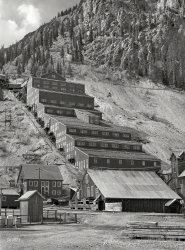
- Central City: 1942
- ... City, an old mining town. Mountainous region of Central Colorado, west of Denver." Acetate negative by John Vachon for the Farm ... the Ida Kruse McFarlane Memorial. https://centralcity.colorado.gov/outdoors
Class Dismissed No lurking mystery on the ... Posted by Dave - 02/13/2022 - 10:47am -
![Central City: 1942 May 1942. "Central City, an old mining town. Mountainous region of Central Colorado, west of Denver." Acetate negative by John Vachon for the Farm Security Administration. View full size.
City Hall?Apparently what appears to be a modest two-family building has now been turned into the city hall, with a suitably large appendage on the right.
WanderlustGoogle imagery has strongly inspired me to visit Central City someday.
A bit of all rightDespite what was in all likelihood a hardscrabble life, involving grueling work in an all-but-overtly hostile environment, those are some nice houses -- especially the one with the matching witch-hat turrets. But I covet the unfinished abode on high ground, looking down on everyone else. And is that a church over there on the right, with the lovely gothic windows? Let us pray.
[That structure up on the hill looks finished in more ways than one. - Dave]
Dave so you think it's old rather than new? I briefly wondered about that but allowed myself to believe they were waiting for me to choose windows and doors and a granite package, plus hardwoods for the floors.
Central City/Black HawkNow twin towns that are the proud environs of more than a few casinos, large and small. Been there many times in the last 20 years. The area is gorgeous.
Lightning Rods Salesman WantedMy first thought about the hollowed out house sitting so high above the others was that it was likely the victim of a lightning strike and fire. When I was a kid, we lived in the highest old Victorian in our neighborhood. Lightning struck with a sound that made us think an atomic bomb might have hit. We didn't have a fire, but sparks rained down all sides of the house. Wherever electrical wires passed behind plaster under windows, curtains were singed & the bottoms fell as if cut by scissors.
My grandfather's sons thought he was nuts for installing lightning rods on his house in 1950.
Here's a house a couple of miles from me that got struck in 2016, for obvious reasons.
[Indeed. - Dave]
The house on the hill.More a memorial these days, to Ida Kruse McFarlane. Many of the buildings in the image are still around, today, you can see the roofline and cupola of the building next door:
More about Ida, here: Ida Kruse McFarlane - Wikipedia
How did you find it?The comment with photo showing the house in the foreground today ... how did you find it without an address? Amazing.
Up on the hillThe building at the top of the hill was the "remains" of the Saint Aloysius Academy. You can see the outline of the foundation on the current satellite view. It is now the site of the Ida Kruse McFarlane Memorial. https://centralcity.colorado.gov/outdoors
Class DismissedNo lurking mystery on the remains of the once vibrant St. Aloysius Academy atop Gunnell Hill in Central City. When it was built, the Sisters had the biggest school in town with room for nearly 200 students but those days had passed when the photo was taken. The foundation of the academy remains with a memorial cross in the same spot atop the hill, which was once reached with a lung aching climb up ten steep staircases from the city streets below.
St. Aloysius.How interesting. My sister and I graduated from St. Aloysius Academy in Rome, N.Y. Like this one, it was closed years ago. In our case, the name was meant to honor a local 19th century priest, the Rev. Aloysius Murphy, pastor of St. Peter's church.
When lightning rods fell from fashionI don't know how true this is, but I've heard that with the advent of indoor plumbing, the conventional wisdom said that you no longer needed a lightning rod, because you had a cast iron plumbing vent stack protruding from the roof, making a good conductor to ground. Then, decades later, when PVC or ABS replaced cast iron, people forgot they had ever used that reasoning.
Google SleuthingSeaelf asked how I was able to find the location, and it's really just because Central City is crazy tiny. The old part of town only has a couple of streets, and this view is urban enough that it's not likely to be on the outskirts. Plus there's an obvious church on the right which helps focus in on possible locations.
House huntingIn answer to seaelf's question, when you drive into Central City, the best parking lot is right where John Vachon was standing. You can't miss seeing that building. The street in the present view leads to Idaho Springs uphill to the left. Central City is indeed a fascinating place; as a photographer I've spent many happy hours there.
(The Gallery, Frontier Life, John Vachon, Mining)](https://www.shorpy.com/files/images/SHORPY-8c22046a.thumbnail.jpg)
- Stress Test: 1936
- ... Kansas My guess is this is far western Kansas, near the Colorado line.
It might be a town like Ulysses, Johnson, Leoti or Tribune. ... Posted by Dave - 07/05/2009 - 1:45am -
![Stress Test: 1936 May 1936. "Bank that failed. Kansas." Medium-format nitrate negative by Arthur Rothstein for the Resettlement Administration. View full size.
Blazing SaddlesLooks more like a Mel Brooks movie set than a financial institution.
Tom GuelkerThis looks like a bank that Dillinger might have assisted in closing, even with the horse hitch out front.
[No to mention the infamous Tom Guelker. - Dave]
It looks like . . .it never even had a chance.
Looks mean nothingThe sleek and shiny, super-size behemoth Merrill Lynch Bank on Wall Street failed just last year and looked much more promising to millions of investors. Don't judge a book by its cover.
No deposit.No returns.
Great expectationsIt's interesting how often these buildings were designed and built in clear anticipation that something else would be built right next to them. It's clearly meant to be a corner block, with the rest of downtown spreading right off its wings. I'd love to know if it still stands today.
Farm equipmentOff to the left there looks to be two threshers, a steam tractor, and some implements. I work at Case IH, a manufacturer of farm and construction equipment. I'll bet they're Case pieces. Thanks Dave!
Long before 1929I'd say this bank, and the surrounding town, died long before
the Depression. Many towns in Western Kansas boomed in the 1870's
based on false expectations and advertising by speculators. When
it turned out that most kinds of farming weren't really practical,
the towns faded and died.
Amost Identical DesignThat failed bank design is almost identical to a bank that failed in my very small Kansas town in 1936. It was vacant for years when an older couple bought it and turned it into their home. Then about 25 years ago it was sold to a man that turned it into a BBQ restaurant. It is very successful and has been highlighted as one of the 10 most unique restaurants in Kansas. It has the original charter and some bank papers hanging on the wall in a frame.
Hitchin' postTie up your horse and come on in.
In KansasAny idea where in Kansas this is? Also curious if the building is still around and what it's now used for.
AnnouncementOur Drive-Up Window will be closed until further notice.
Looks like western KansasMy guess is this is far western Kansas, near the Colorado line.
It might be a town like Ulysses, Johnson, Leoti or Tribune. It's a shame there's not more to go on. Much east of there and you see at least a few trees of which this photo has none.
Many of the old stationary threshers as pictured are still scattered around that country, to this day. They haven't served a purpose other than yard art since before WW2. Some machinery is too hard to part company with.
[This photo is among dozens taken by Arthur Rothstein in Jefferson and Cherokee counties in eastern Kansas. - Dave]
From Bank to RestaurantIn the early 80`s there was a restaurant north of Detroit located in a former bank. What impressed me was the salad bar, named "The Green Stuff," was in the vault.
I beg to differ!Ummm. There is no Columbus County in Kansas. The city of Columbus, however, is in Cherokee County.
[Oops. I meant Jefferson and Cherokee counties. - Dave]
A lot of towns diedI lived in an area of Kansas where several small towns once existed. Now you'll be lucky to find the town name on a map. Some towns were completely wiped from the face of the earth. There are no remnants left to know that anything was there. Just open farm ground. Towns like Ray, Hopewell, Neola, Zook just to name a few. You have to wonder how much different the state would be if things had turned out the way these towns had hoped.
(The Gallery, Arthur Rothstein, Great Depression)](https://www.shorpy.com/files/images/8b27620u.thumbnail.jpg)
- The Scenic Route: 1941
- ... through the mountains from Idaho Springs to Central City, Colorado." Photo by Marion Post Wolcott for the Farm Security Administration. ... could look down a long, long way to the bottom.The law in Colorado says that the person coming down has to give way to the person coming ... Posted by Dave - 02/14/2020 - 6:16pm -
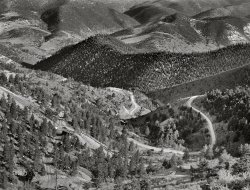
- Ophir Station: 1940
- September 1940. "Railway station at Ophir, Colorado, a small gold mining town. A narrow-gauge railway runs into the town ... Iconic view This is -the iconic photo- of -the iconic Colorado Narrow Gauge railroad-, the Rio Grande Southern. Lots of people have ... Posted by Dave - 09/04/2018 - 1:16pm -
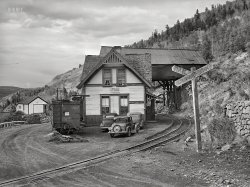
- Mexican Central Railway: 1891
- ... Michigan. In 1949, Jackson's negatives were donated to the Colorado Historical Society, which kept the Western U.S. photos and gave the ... Posted by Dave - 07/26/2012 - 4:53pm -
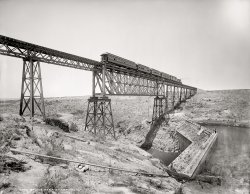
- Ask Us About Our Poultry: 1942
- ... the chrome on his Peterbilt semi at a truck stop in Colorado. Geez, talk about a clash of cultures.
Obviously chilly Those ... Posted by Dave - 03/09/2010 - 10:10am -
![Ask Us About Our Poultry: 1942 November 1942. Lititz, Pennsylvania. "Mennonite farmer and wife at the farmer's market." These folks look like they'd be only too happy to bend your ear about their birds. Photo by Marjory Collins, Office of War Information. View full size.
Lots of Mennonite flavors.Mennonites come in lots of different flavors.
"Old Mennonites" appear in dress and lifestyle about like the Amish. "New (moderate) Mennonites" aren't much different in either than a regular ol' Protestant is.
This Mennonite couple appears to be rooted somewhere between the Mennonite extremes. Or perhaps they're a (gasp) mixed marriage?
One of the funniest things I've ever seen was what appeared to be an Old Order Mennonite in his simple, conservative dress polishing the chrome on his Peterbilt semi at a truck stop in Colorado. Geez, talk about a clash of cultures.
Obviously chillyThose birds have goosebumps.
Not AmishHow to tell an Amish from a Mennonite? He's got buttons! Oddly, though, I can't say that I've ever seen an Amish or Mennonite person wearing a sweater.
There is a large Mennonite and Amish population in my hometown, and it's always interesting to see where they give in modern conveniences. A few weeks ago, I saw a couple walking through WalMart. Among the things in their basket was a hose (can't make that at home, I suppose). One of the first people my friend sold a box of condoms to when she worked in a grocery store in high school was an (apparently liberal!) Amish man. And when I worked in retail, the women would often come in to purchase luggage and undergarments - I still remember selling a VERY flashy pink, sparkly, embroidered bra to one young Amish lady!
I wonder how this couple would feel about all that!
No Wings HereWhat a lovely looking couple. Love the Lennon specs!
Lost ArtHow to pluck, singe, and dress a fresh chicken.
I wonder what she has in those jars ?
Cheap chickensI note the prices on those chickens... $1.58, $1.58, $1.98.
Can't get a leg for that little, now.
[Whole rotisserie chickens are $4 at my local grocery. (And they're quite delicious.) When you take inflation into account, a whole chicken now is much cheaper than any of these Mennonite chickens. - Dave]
Yard BirdsBetween the Colonel and Hooters the only thing left over now days is the beak and the feet.
She understands that more than one mennonite is being greedy.
ScrawnyWow, those are some anemic-looking chickens.
Sixty years of genetic selection and chemistry has given us much bigger birds. I'd like to do a taste-comparison with one of these.
Size MattersNotice their size as compared to the hormone-fueled behemoths you find in grocery stores today.
["Hormones" aren't used to grow poultry, at least not in the United States. - Dave]
Lititz Farmers MarketMy guess would be that this photo was taken at some version of the Farmers Market. Currently it is held every Saturday morning from May until October. Would not surprise me if descendants of these folks are still selling fresh chickens on Saturday mornings.
Fark this!C'mon, Dave, ya gotta Fark this one!
[News Flash: I have no influence over whether something gets Farked. That's up to the Fark people. - Dave]
Not what you'd expectWe have a lot of Mennonite families locally. The area supermarkets' paperback sections stock Mennonite romance novels, complete with cover art of young, neatly capped, dewy-eyed heroines.
Now, that's a sub-genre!
Mennonite RomanceAmish and Mennonite romance novels are actually a huge literary subgenre. They generally fall under "inspirational romance," and lots of people read them, actually. (I work for a publisher.) They certainly are ... interesting.
Last week at my library's annual used book sale the Amish/Mennonites were racking up on books! Among those that the man in front of us got was a very large "Uncle John's Bathroom Reader." A girl had a bio of Pope John Paul.
Jam sealed with paraffin I would bet that those jars are filled with some kind of lovely jam or jelly, sealed with paraffin. I'd have loved to help her put up the jam, but I'm glad I didn't have to assist in the killing, plucking and cleaning of all those chickens!
(The Gallery, Marjory Collins, Stores & Markets)](https://www.shorpy.com/files/images/8d23535u.thumbnail.jpg)
- Sherman Avenue: 1908
- Denver circa 1908. "Sherman Avenue and Colorado statehouse." 8x10 glass negative by William Henry Jackson, Detroit ... of the front.
+104 From about the same spot. The Colorado State House is actually two long blocks away, not as close as the 1908 ... Posted by Dave - 08/21/2012 - 8:37pm -
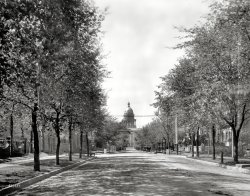
- Galen Gough: 1923
- ... as GM's CEO.
Obit for Galen Gough Try newspapers in Colorado Springs CO. That's where he's buried.
Why I love Shorpy.com ... Posted by Dave - 09/11/2011 - 8:49pm -
![Galen Gough: 1923 October 5, 1923. Washington, D.C. The war hero and former invalid Galen Gough, known as the "Miracle Strong Man" after recovering from having his head caved in by bomb shrapnel in France. National Photo Co. glass negative. View full size.
Ow.The last time I had my head caved in was at an LL Cool J concert.
The Original JackassWashington Post, Oct 4, 1923
Will Be Run Over By Auto
"Fun-Fest" Strong-Man to Show He Can Not be Injured
Galen Gotch [sic], former marine and strong man who appears nightly at the Coliseum, claims that he can be run over by an automobile with five passengers in it without being hurt.
To substantiate his claim he plans to submit himself to such a test tomorrow afternoon at 12:30 o'clock at the intersection of E street and Pennsylvania avenue northwest.
Galen Gough, 1899-1962The Strange Saga of Galen Gough (PDF)
ObituaryAnyone find an obituary for Galen Gough on Oct 6, 1923?
'23 DurantThe car is a 1923 Durant, named after William C. Durant, founder of General Motors.
Old-school strongmenThey weren't chiseled or cut, but they could pull off some sick feats of strength.
BiographyThis guy was pretty cool!
http://home.newwavecomm.net/westoaks/ggbio.html
CrapoMr. Durant's middle name was Crapo, which is no doubt why he only used the letter C in his name. He introduced the Durant following his second and final ouster as GM's CEO.
Obit for Galen GoughTry newspapers in Colorado Springs CO. That's where he's buried.
Why I love Shorpy.comPhotos like this and the amazing stories about the people represented in them. Keep up the good work.
(The Gallery, Cars, Trucks, Buses, D.C., Natl Photo, Sports)](https://www.shorpy.com/files/images/24733u.thumbnail.jpg)
- Blind Curve: 1941
- ... on the west side of the Rocky Mountains from Leadville, Colorado." Medium format acetate negative by Marion Post Wolcott for the Farm ... was formerly the Busk-Ivanhoe Tunnel of the late lamented Colorado Midland Railway, maintained for many years as a toll tunnel business ... Posted by Dave - 06/18/2020 - 3:42pm -
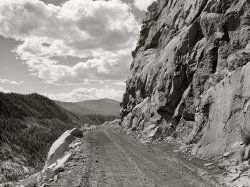
- Ouray Bakery: 1940
- September 1940. "Store buildings at Ouray, Colorado." Medium format acetate negative by Russell Lee for the Farm Security ... built this store in 1900 on the main street of Ouray, Colorado. It is still a family-owned grocery store with hours of 8 am to 6 pm, ... Posted by Dave - 09/30/2018 - 3:29pm -
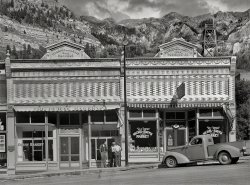
- Open House: 1936
- ... the same in store for the Oklahoma / West Kansas / Eastern Colorado / North Texas areas in the mid to late 30's, but was of shorter ... Posted by Dave - 08/18/2013 - 10:39am -
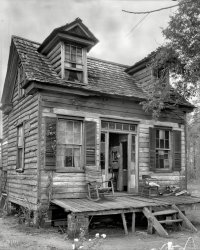
- Man of Steel: 1942
- May 1942. "Denver, Colorado. Interior of a shipbuilding plant, showing workman who previously ... with prefabricated sections brought in from as far away as Colorado. Warships damaged in battle were also repaired and refitted in the ... Posted by Dave - 06/24/2015 - 11:48am -
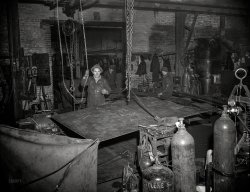
- Ouray: 1901
- Colorado circa 1901. "Ouray from Blow-out Canyon." 8x10 inch dry plate glass ... Posted by Dave - 04/30/2020 - 2:10pm -
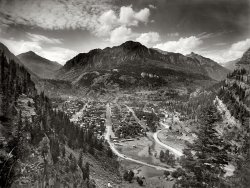
- Quality Store: 1940
- September 1940. "General store. Ophir, Colorado, a small gold mining town on the side of a mountain." Photo by Russell ... Posted by Dave - 11/06/2021 - 2:41pm -
![Quality Store: 1940 September 1940. "General store. Ophir, Colorado, a small gold mining town on the side of a mountain." Photo by Russell Lee for the Farm Security Administration. View full size.
Feline mienOlder gentleman seated in front of the store reminds me of cats in pictures who look toward the photographer as if knowing that they're the main subject.
There must be a catBehind the gas pump, because that beautiful little boy in the window is surely captivated by something.
Ruff TimesAccording to the town's website -- Population: 180 humans, 51 dogs
CrackerjackTwo boxes, please.
Cat tracks?? No: train tracks...Tho not apparent here, this store actually fronts on a railroad line
https://ngtrainpics.photoshelter.com/img/pixel.gif
High, low or middling?"Quality store", sure, but where on the scale from great to not so?
It's the stanceI recognized Sailor Jack on the Cracker Jack boxes right away. Then again, I ate so much of the stuff, I was once dubbed the Cracker Jack Kid by a local Five and Dime store owner.
No, we live like this all the timeThe owner of the Ophir general store must have received notice Russell Lee was coming to take a picture. The store has a new coat of paint and the stairs and boardwalk are in tiptop shape.
Rock guardianBeautiful, up to date fuel pump situated in a very vulnerable and awkward to access location. Underground tank filler pipe "protection" is a couple of strategically placed rocks.
"Ophir there," as they sayon the other side of the San Juan Mountains.
I've been to Ophir--it's fairly remote and quite inaccessible. It always amazes me to see photos like this from 80 years ago, and to imagine how people carted supplies (and themselves, for that matter) to such a place with limited means of transportation and communication.
[Someday they may invent vehicles which can finally make use of that gasoline pump. -tterrace]
(The Gallery, Frontier Life, Gas Stations, Russell Lee, Small Towns, Stores & Markets)](https://www.shorpy.com/files/images/SHORPY-8b26087a.thumbnail.jpg)























